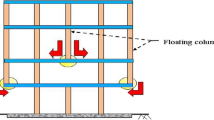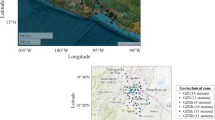Abstract
In this paper a numerical study on the effects of the basin edge on the dynamic behavior of the model basins are investigated. For this purpose a range of bedrock inclinations at the valley sides from slighter \(10^{\circ }\) and \(20^{\circ }\) to steeper \(30^{\circ }\) and \(40^{\circ }\) are selected. A numerical study using nonlinear code which utilizes appropriate static and dynamic boundary conditions, and includes hysteresis damping formulation based on user defined degradation curves is conducted utilizing two sandy and clayey materials. Using several different real earthquake motions provide opportunity for the assessment of the site response to the variation of the motion intensity. The analyses results are presented in the form of the acceleration and spectral acceleration amplification curves. Also, by conducting 1D analyses along the valley the aggravation curve for every case are evaluated and discussed. It was seen that variation of the bedrock inclination not only affects the peaks of the spectral amplification curves, but also the position of the maximums of the curves on the valley surface are changed. Also, the frequency domain results show that different parts of the valleys are sensitive to different periods. While the lateral parts are sensitive to lower periods, the maximum amplification of the inner parts takes place at higher periods. Based on results the 2D behavior not only is dominant at the latreal parts of the valley, but also affects the behavior of the inner parts. Also, the use of the 1D analyes for the estimation of the 2D behavior remains insufficient. Finally, the results of this research show the important effect of the motion intensity on the 2D behavior of the valley specially on the increase of the resonance period at higher period.
















Similar content being viewed by others
References
Alvarez S, Sanchez-Sesma FJ, Benito J, Alarcon E (2004) The direct boundary element method: 2D site effects assessment on laterally varying layered media (methodology). Soil Dyn Earthq Eng 24:167–180
Assimaki D, Gazetas G (2004) Soil and topographic amplification on canyon banks and the 1999 Athens earthquake. J Earthq Eng 8(1):1–43
Assimaki D, Jeong S (2011) Coupled topography-stratigraphy effects during the m 7.0 Haiti earthquake: the case of hotel Montana. In: 4th IASPEI/IAEE international symposium, University of California Santa Barbara
Assimaki D, Pecker A, Popescu R, Prevost JH (2003) Effects of spatial variability of soil properties on surface ground motion. J Earthq Eng 7(1):1–44
Assimaki D, Kausel E, Gazetas G (2005) Wave propagation and soil-structure interaction on a cliff crest during the 1999 Athens earthquake. Soil Dyn Earthq Eng 25:513–527
Bakir BS, Ozkan MY, Ciliz S (2002) Effects of basin edge on the distribution of damage in 1995 Dinar, Turkey earthquake. Soil Dyn Earthq Eng 22:335–345
Chavez-Garcia FJ, Raptakis D, Makra K, Pitilakis K (2000) Site effects at Euroseistest- II. Results from 2D numerical modeling and comparison with observations. Soil Dyn Earthq Eng 19:23–39
Cundall PA (2008) FLAC3D Manual: a computer program for fast Lagrangian analysis of Continua (Version 4.0). Minneapolis, MN, USA
Cundall PA et al (1980) NESSI—soil structure interaction program for dynamic and static problems. Norwegian Geotechnical Institute, Report 51508-9
Faccioli E, Vanini M, Frassine L (2002) “Complex” site effects in earthquake ground motion, including topography. In: 12th European conference on earthquake engineering, Paper Reference: 844
Finn WD, Zhai E, Thavaraj T, Hao XS, Ventura CE (2003) 1-D and 2-D analyses of weak motion data in Fraser Delta from 1966 Duvall earthquake. Soil Dyn Earthq Eng 23:323–329
Frankel A (1993) Three dimensional simulation of ground motion in the Santa Bernardino Valley, California, for hypothetical earthquake on the San Andreas fault. Bull Seismol Soc Am 83:1020–1041
Gelagoti F, Kourkoulis R, Anastasopoulos I, Tazoh T, Gazetas G (2010) Seismic wave propagation in a very soft alluvial valley: sensitivity to ground-motion details and soil nonlinearity, and generation of a parasitic vertical component. Bull Seismol Soc Am 100(6):3035–3054
Gil-Zepeda SA, Montalvo-Arrieta JC, Vai R, Sanchez-Sesma FJ (2003) A hybrid indirect boundary element-discrete wave number method applied to simulate the seismic response of stratified alluvial valleys. Soil Dyn Earthq Eng 23:77–86
Goto H, Sawada S (2004) Numerical simulation of strong ground motion on Adapazarı basin during the 1999 Kocaeli, Turkey, earthquake. In: 13th World conference on earthquake engineering, Vancouver, BC, Canada, Paper No. 720
Hasal ME, Iyisan R (2012) Effect of edge slope on soil amplification at a two dimensional basin model. In: 15th WCEE, Lisbona, Paper no: 4455
Heymsfield E (2000) Two-dimensional scattering of SH waves in a soil layer underlain with bedrock. Soil Dyn Earthq Eng 19:489–500
Ishibashi I, Zhang X (1993) Unified dynamic shear moduli and damping ratios of sand and clay. Soils and foundations, Japanese Society of soil mechanics and foundation engineering 33(1):182–191
Iyisan R, Hasal ME (2007) The effect of ground motion characteristics to the dynamic response of alluvial valley models. In: 13th Asian regional conference of soil & geotechnical engineering, Theme-7 Dam Engineering, Paper Code 7.1-8, Kolkata
Kamiyama M, Satoh T (2002) Seismic response analysis of laterally inhomogeneous ground with emphasis on strains. Soil Dyn Earthq Eng 22:877–884
Kamalian M, Jafari MK, Sohrabi-Bidar A, Razmkhah A, Gatmiri B (2006) Time domain two-dimensional site response analysis of non-homogeneous topographic structures by a hybrid BE/FE method. Soil Dyn Earthq Eng 26:753–765
Kawase H, Aki K (1989) A study on the response of a soft basin for incident. S, P and Rayleigh waves with special reference to the long duration observed in Mexico City. Bull Seismol Soc Am 79:1361–1382
Khanbabazadeh H, Janalizadeh A (2006) Investigation of the site effect on seismic ground motions using elasto-plastic constitutive model. EJGE Vol 11–Boundle A
Kuhlemeyer RL, Lysmer J (1973) Finite element method accuracy for wave propagation problems. J Soil Mech Found Div ASCE 99(EM5):421–427
Lysmer J, Kuhlemeyer RL (1969) Finite dynamic model for infinite media. J Eng Mech 95(EM4):859–877
Makra K, Chavez-Garcıa FJ, Raptakis D, Pitilakis K (2005) Parametric analysis of the seismic response of a 2D sedimentary valley: implications for code implementations of complex site effects. Soil Dyn Earthq Eng 25:303–315
Paolucci R (1999) Shear resonance frequencies of alluvial valleys by Rayleigh’s method. Earthq Spectra 15(3):503–521
Paolucci R, Faccioli E, Maggio F (1999) 3D response analysis of an instrumented hill at Matsuzaki, Japan, by a spectral method. J Seismol 3(2):191–209
Paolucci R, Faccioli E, Chiesa F, Cotignola R (2000) Searching for 2D/3D site response patterns in weak and strong motion array data from different regions. In: Proceedings of the 6th international conference on seismic zonation (6ICSZ): “Managing Earthquake Risk in the 21st Century”, Palm Springs, CA. Paper no. 00147. EERI, November 12–15
Ramos-Martinez J (1992) Simulación numérica de la respuesta sismica de valles aluviales. Dissertation, MSc Thesis, Institute of Geophysics, UNAM
Rodriguez-Castellanos A, Sanchez-Sesma FJ, Ortiz-Aleman C, Orozco-del-Castillo M (2011) Least square approach to simulate wave propagation in irregular profiles using the indirect boundary element method. Soil Dyn Earthq Eng 31:385–390
Rovelli A, Scognamiglio L, Marra F, Caserta A (2001) Edge-diffracted 1-s surface waves observed in a small-size intermontane basin (Colfiorito, central Italy). Bull Seismol Soc Am 91:1851–1866
Safak E (2001) Local site effects and dynamic soil behavior. Soil Dyn Earthq Eng 21:453–458
Sanchez-Sesma FJ, Luzon F (1995) Seismic response of three-dimensional alluvial valleys for incident P, S and Rayleigh waves. Bull Seismol Soc Am 85:269–284
Sanchez-Sesma FJ, Ramos-Martinez J, Campillo M (1993) An indirect boundary element method applied to simulate the seismic response of alluvial valleys for incident P, S and Rayleigh waves. Earthq Eng Struct Dyn 22:279–295
Semblat JF, Kham M, Parara E, Bard PY, Pitilakis K, Makra K, Raptakis D (2005) Seismic wave amplification: basin geometry vs soil layering. Soil Dyn Earthq Eng 25:529–538
Zahradnik J (1995) Simple elastic finite-difference scheme. Bull Seismol Soc Am 85:1879–1887
Zhang J, Zhao JX (2009) Response spectral amplification ratios from 1- and 2 dimensional nonlinear soil site models. Soil Dyn Earthq Eng 29:563–573
Acknowledgments
This work has been performed under the support of the “BAP” project (scientific research project) of the Istanbul technical university. Hereby, the authors express their gratitude.
Author information
Authors and Affiliations
Corresponding author
Rights and permissions
About this article
Cite this article
Iyisan, R., Khanbabazadeh, H. A numerical study on the basin edge effect on soil amplification. Bull Earthquake Eng 11, 1305–1323 (2013). https://doi.org/10.1007/s10518-013-9451-6
Received:
Accepted:
Published:
Issue Date:
DOI: https://doi.org/10.1007/s10518-013-9451-6




